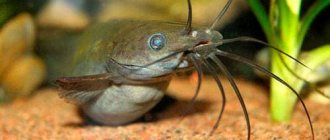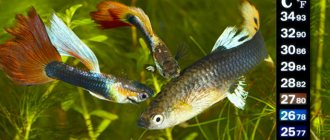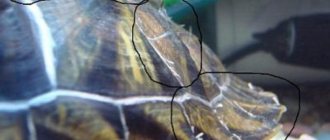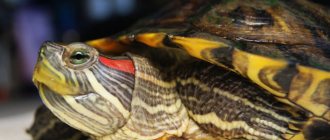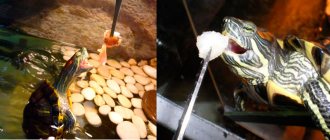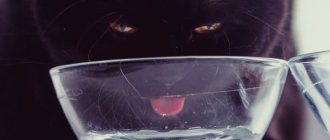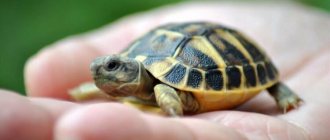Many people dream of having a red-eared turtle as an unpretentious pet, but before making this dream a reality, you should know the basic requirements that must be met in order for the freshwater creature to feel great in a person’s home or office space.
So, what you need to pay attention to:
- What water temperature should be maintained in the aquarium?
- How to create optimal conditions for keeping a turtle?
- Rules for keeping the aquarium clean.
Coast heating and temperature maintenance
As for the coastline, it is necessary so that the hero of our story can get out and warm up.
The land line itself must occupy at least 25% of the entire aquaterarium. It is best to buy it in a store, but you can make it yourself. The main thing is that the island has sloping shores. The shoreline should be illuminated with UV lamps, which will provide warming, because the temperature on the shore must be 10 °C higher than the water temperature. Too high is also undesirable, so as not to provoke overheating. The height of the lamp is about 25-30 cm. If it is installed lower, the pet will receive eye burns.
Turtles are heat-loving animals and, living in natural conditions, they love to bask in the sun. To bring the maintenance at home closer to natural conditions, you will need to install a heating lamp. To maintain optimal temperature in the aquarium there must be a thermometer. The operating time of the heating lamp is 10-12 hours a day.
What to do when turtles breed?
Despite the fact that these animals are rarely bred at home, anything can happen, and you need to be prepared for it. Firstly, there should be a small layer of soil at the bottom, since this is where the female buries her offspring. It is necessary to slightly raise the minimum temperature threshold. The water must be heated to 25 degrees Celsius - only in such conditions will the masonry ripen. You can use sand as a primer or mix it with something else. After the clutch appears, hurry to move it to another place, as there is a high probability that the eggs will be damaged by adults. In a separate aquarium, it is necessary to maintain a soil temperature of at least 21 degrees. Please note that the red-eared slider, the small one in particular, requires good nutrition. This way you can significantly speed up its development.
Temperature limits
For a red-eared turtle living in an aquarium, it is important to maintain a comfortable temperature of water and land. If there is no balance, the pet faces:
- Slow growth and development of diseases associated with decreased activity. This situation occurs when the water is too hot, forcing turtles to come ashore more often.
- Lethargy and loss of appetite. Cold water (10-15°), slowing down all internal processes, drives reptiles into a state of hibernation.
In the wild, red-eared turtles live in the tropical zone, so they prefer warm temperatures not only on land, but also in water:
- the temperature on the island used by reptiles for resting and warming up must be at least 23 degrees in the shade and no more than 32 degrees in the light;
- The optimal water temperature for the continued activity of pets should be from 22 to 28 degrees.
How to arrange a home for turtles?
After we have figured out the water temperature and the size of the aquarium, we need to arrange everything there correctly. Doing this is not as difficult as it might seem at first glance. First, create land. This can be done in several ways, for example, by pouring a small handful of special stones. It is advisable that there are no sharp edges, so the animal cannot get hurt. Another solution is to install the glass at a 45-degree angle and seal it with a non-toxic sealant. Place stones on the glass and make a special edge to prevent them from rolling down. You also need to decide whether there will be live plants in the aquarium. In principle, everything that the animal finds edible will be immediately consumed in its daily diet; the turtle will simply vomit everything else. The issue can be partly solved by purchasing ornamental plants or driftwood that are securely attached to the bottom. If you do everything correctly, keeping red-eared turtles will not be a problem for you.
Description of the red-eared turtle
The wrinkled shell of an adult red-eared turtle can reach a length of 28 cm, depending on the subspecies. The spot behind their eyes is not only bright red, but also bright yellow. In general, the colors of these turtles are extremely diverse, and in addition, they change greatly with age. Young animals are usually bright green, but older ones can turn completely black.
The plastron of red-eared turtles is bright yellow with dark round spots. Male ornamental turtles have a long tail and long claws, no notch on the plastron, and a slightly more pointed nose than females. Females have short claws and a short tail. Females (18-22 cm) are usually larger than males (14-16 cm). During the first 1.5 years of life they are able to grow up to 7.5 cm, then growth slows down and the turtle grows 1-1.25 cm per year.
https://youtube.com/watch?v=C1BVZi5li4w
In the first 2 years, a turtle is quite capable of growing to 20 cm or more, i.e. the turtle is not dwarf or decorative, as sellers often convince naive buyers of. Trachemys scripta scripta - Length up to 27 cm. It has a very noticeable yellow postorbital spot connected to a stripe on the neck. Each costal scute of the carapace has a yellow stripe.
The plastron is yellow with spots on most of the anterior scutes. Trachemys scripta elegans - Length up to 28 cm. The head has a wide red postorbital stripe and narrow stripes on the chin. On each costal carapace there is a transverse yellow stripe. Plastron with a large spot on each scute. Trachemys scripta troostii - Length up to 21 cm.
Aquaterrarium
This is the correct name for the place where the red-eared turtle should live. Aqua- (water) and terra- (earth) - the turtle should be able to swim and crawl onto the shore (island) as needed. The volume of water for an average-sized turtle needs at least 60 liters, the container is mainly of a horizontal type. The older the turtle, the more time it spends on land, which means it makes sense to increase the island as the pet grows.
Aquaterrarium for the red-eared turtle.
Another important point is maintaining water quality. Little Reds are assholes! They eat sloppily, poop and pee a lot, so maintaining water quality is a top priority. The following things will help you achieve cleanliness in your aquarium.
- Filter. Optimally - internal, with a good flow reserve (3-4 volumes per hour) and a large sponge. There is no reason to install an external filter: anyway, it will not be possible to completely close the nitrogen cycle (as in an aquarium with fish), and the cost of good external filters is very high.
- Feeding outside the aquarium. Teach your animal from a very early age to receive food in a separate container. It is better to take water into the container directly from the aquarium - this way you will maintain the usual chemical and physical parameters of the water. After feeding, the water should be poured out of the container and fresh water should be added to the aquarium. This way, scraps are prevented from getting into the living space and at the same time a kind of “ventilation” is carried out by replacing part of the water.
- It is useful to change the water from time to time - about half the volume weekly. Fresh water should be at the usual temperature. In a large aquarium, it is convenient to do the change using a large hose - drain the required amount of water into a bucket or directly into the toilet and pour it back through the same hose directly from the tap, if you have coarse water filters in your house. If there are no filters, then cold water is mixed with boiling water in a separate bucket until the desired temperature is reached. Water conditioners should be used in spring and autumn, when melted snow or heavy precipitation from city streets enters the central water supply. It is very inexpensive to use pond conditioners - they do not differ in composition from aquarium conditioners, but are more concentrated. The air conditioner is calculated based on the volume of water being replaced, and not on the entire volume of the aquarium.
- It is permissible for turtles to change the water completely. If you missed changes and/or the water has an unpleasant odor, you can completely change the water by wiping the decorations and walls of the aquarium with a sponge. When completely changing the water, it is also advisable to use an air conditioner. There is no need to constantly wash the aquarium - the water should normally have a pleasant “living” smell, like a lake or a slow-moving river.
Details about the aquatic environment
When keeping your pet indoors, you should carefully monitor the depth of the reservoir. It directly depends on the pet’s age category and size. The turtle should move freely.
Fresh water can be used, but it should have medium hardness, with an active pH reaction in the range of 6.5-7.5. This is the average for tap water, but taking it from the tap is not recommended.
Everyone knows that tap water is disinfected by adding chlorine to it, which disappears only 24 hours after settling. This is the settled water that can be poured into the aquarium during cleaning. It is not worth changing the water completely, because the necessary microflora is formed in the container over a long period of time, and beneficial microorganisms mature. Cleaning is required frequently, and if you change the entire water every time, the aquarium will not have the necessary ecosystem.
Caring for your turtle
The first thing you should pay attention to when purchasing a pet is its appearance and size. A turtle that is under 5 cm in size at the time of purchase will be very difficult to raise.
At this age, small individuals are susceptible to various infections and diseases. This is how natural selection takes place. Therefore, a turtle 5–7 cm in size will be the best choice when purchasing.
You should also carefully examine the color of the shell. The claws and tail must be intact. The skin looks healthy and the eyes shine. After the pet is in the aquarium, watch how it swims. A healthy turtle should swim smoothly, without leaning in different directions.
Healthy turtle
Features of treatment
After purchasing a pet and moving it into an aquarium, it may go through an adaptation period. Typically it will take 2 to 5 days. At this time, the animal becomes a little inhibited, or, conversely, very active. There is no need to panic and pick up the animal. Give him peace and time to adapt to new conditions. After a while, the turtle will get used to the new environment and become calmer.
When trying to pick up a turtle, do it very carefully and always with both hands. Not all representatives are willing to make contact. Some may flounder, hiss, and defecate in fear. The shell becomes slippery in water; keep this fact in mind when removing your pet from the aquarium.
After you hold the turtle in your hands, be sure to wash them with soap. Despite being kept clean, turtles are often carriers of salmonellosis. To avoid the spread of infection, you must always monitor the condition of the aquarium and the quality of the food.
Cleaning the shell
Since green algae in an aquarium is a source of infection, it is important to regularly clean not only the container, but also the turtle’s shell. They can't do it themselves
During the decomposition process, algae also fall under the surface of the shell, and as they decompose, they harm the shell.
You will get used to the fact that once every 3-5 days you need to take the turtle out of the water and wipe its shell with a clean cloth, a special soft napkin, or gently brush it with a toothbrush. During the process, you should try to remove all small particles of algae and other dirt.
Cleaning the shell with a toothbrush
Some unscrupulous owners try to make the turtle's shell beautiful and lubricate it with various oils or creams to add shine. This is strictly prohibited, as it harms the skin and interferes with the healthy “breathing of the body” of the pet.
When cleaning a turtle's shell, you should not use various oils and kerma, as this will harm your pet's health.
Water temperature
So we have come close to the main question of the article, what should be the temperature of the water in the aquarium?
Temperature control must be observed regularly and very carefully. The reasons for this are:
- If the temperature drops, the turtles eat poorly due to lack of appetite, they become quite passive. As a result, the immune system suffers, and, if measures are not taken, death.
- An increase in temperature will lead to the fact that the turtle will spend a long period on land, because it will feel unwell in the water. Because of this, the growth and activity of the pet will stop.
Creating ideal living conditions for red-eared turtles is not so easy. It will take quite a bit of effort. Experts recommend purchasing an oblong-shaped aquarium; water in it will occupy ¾ of the part.
The water temperature directly depends on the time of year, as in principle does the light regime of the day. The optimal indicators are:
- From December to May inclusive - not lower than 20 degrees, if daylight lasts 8 hours - 25 degrees.
- From June to August inclusive - with daylight up to 13 hours - 25-28 degrees.
- From September to November inclusive - with 8 hours of daylight - 22-26 degrees.
For small turtles (up to 3 years old), the temperature in the aquarium should not drop below 25 degrees.
If the deviations in temperature were short, then there is no need to worry, but long-term deviations can lead to illnesses in your pet, problems with the lungs and skin.
You can maintain normal temperatures in an aquarium using an ordinary submersible aquarium heater. It is equipped with a thermostat. To heat the land, it is advisable to use other auxiliary heaters. For this purpose, special lamps for reptiles are used. But you can use a regular 60-watt light bulb, a solar medical light bulb, or an ultraviolet light bulb. A mirror-coated lamp is also suitable. They are installed in a certain area of the aquarium. To prevent the turtles from getting burns, the lamps are placed at a height of up to 60 centimeters from the water level.
Conditions for keeping red-eared turtles
All three subspecies of turtles —
representatives of a semi-aquatic lifestyle. In addition, they are all carnivores and begin to eat plant foods only in adulthood.
They also require certain temperature conditions, lighting conditions and ultraviolet irradiation.
Aquaterrarium for the red-eared turtle
What is a terrarium?
This is a specially equipped place created for keeping reptiles. In this case, we are dealing with an aquaterrarium, since the red-eared turtle needs both land and water. Keeping them in boxes, basins, and buckets is absolutely not suitable for them! In addition, we must remember that our turtles should live only in their “house” and under no circumstances “walk” around the apartment. They can only be handled for a very short amount of time: during transplantation for feeding or cleaning.
The future size of our turtles indicates that they need enough space to fully grow and develop. But this does not mean at all that you can immediately release small turtles into a large aquaterrarium. Every age —
your own “house”, according to size.
The terrarium for the red-eared turtle should be horizontal (rectangular in length). Adult pets require “houses” with a volume of at least 150 liters, and children —
about 50 l. Ordinary small turtles, which are sold in pet stores, can also be suitable for very small children.
As for the location of the aquaterrarium in the apartment, a more suitable place is in the back of the room. During the autumn-winter period, it is better not to open the windows in the room where your turtle is kept to avoid a cold draft. Yes, it is deadly for your cold-blooded pets, since a “cold” can cause a disease such as pneumonia, which becomes clearly visible when the turtle is already fully ill.
Aquaterrarium equipment
What should be required in every aquaterrarium: a thermometer to control the water temperature, a shore, a water heater and a water filter.
The presence of algae and stones is not necessary and is sometimes contraindicated. Some types of algae are toxic, and stones can be swallowed and cause a blockage in the esophagus or intestines; In addition, they make cleaning more difficult. But if you still decide to decorate your terrarium in this way, then remember that the size of the stones should not be smaller than the turtle’s head, the stones themselves should not crumble and be multi-colored (they can release toxic substances when heated). It is better to select algae after preliminary consultation with a specialist.
Coastal part of the aquaterrarium
Why does an aquaterrarium need a shore? Turtles —
cold-blooded animals that are not capable of creating heat with their own bodies, as we mammals do. In nature, turtles crawl ashore to warm up and take a break from swimming; the same should be done for them at home.
Land should not occupy more than 1/3 of the aquaterrarium. The angle of rise out of the water should not be too obtuse or straight. It must be sharp and motionless so that the exit from the water does not “run away” from the turtle. The shore itself must be made of a sufficiently durable material, without easily peeling paint and odorless.
Lighting
Lighting will be required of two types: one for heating, the other —
ultraviolet.
These two types of irradiation have only the following in common:
- Both lamps must be installed above the shore.
- The distance to the shore should not be less than 30 cm.
- Both lamps should burn for about 12 hours.
Now let's talk about each type separately.
Ultraviolet lamp for red-eared turtles
In the case of reptiles, only special lamps are used that are suitable only for them. Each such lamp has its own percentage of ultraviolet light (UVB) emitted: 2% (2.0), 5% (5.0) and 10% (10.0). 5% (5.0) lamps are suitable for turtles.
What is it for, you ask? If you do not go into the specific physiology of reptile metabolism, then without ultraviolet light calcium will not be fully absorbed and the gastrointestinal tract will not function, which will lead to quite dangerous and serious diseases in both adults and small turtles.
Thermal lighting
Conventional 60 W incandescent lamps are suitable for this type of lighting. This type is required so that your turtles do not freeze while out of water and can warm up normally for the full functioning of their body.
Water in the aquaterrarium
This is one of those points that should not be ignored under any circumstances, since it is in this environment that healthy turtles spend most of their time.
For our pets, filtered water or water that has been standing for at least a day is suitable. If the water was first filtered and then settled —
you are a very good host. In this case, we are engaged in the prevention of many diseases of the shell and skin.
Water temperature in an aquarium for red-eared turtles
To create comfortable living conditions for our reptiles, we will need to maintain certain temperature conditions!
The water temperature should be between 22-25 0C. It can be maintained either with the help of special heating mats (provided that the size of the aquaterrarium is small enough) or with water heaters, which can be used to set the appropriate temperature. To constantly monitor the temperature, you will need a special thermometer, which must be installed in the water. In addition, it needs to be protected from the curiosity of our pets, as they can damage it, which will lead to hazardous substances getting into the water and poisoning the body.
We maintain the shore temperature using a heating lamp. You can control it by adjusting the height of the lamp. Normally, the shore temperature should be in the range of 30-32 0C.
Aquarium water
The amount of water in the aquaterrarium should be sufficient for the turtle to move freely. As a rule, the water level reaches about 25 cm and can fluctuate within small limits, depending on the age of the reptile.
The turtle needs fresh water with a pH reaction in the range of 6.5-7.5, which corresponds to ordinary tap water. But given the fact that the water is treated with chlorine, such water must be left to stand for 24 hours. Chlorine is a volatile substance and during this time there will be practically no trace of it in the water. This water is used for partial replacement.
It is not recommended to completely replace the water, so as not to disturb the microclimate and ecosystem of the aquaterrarium. In this case, it is better to perform partial water changes more often during cleaning.
Features of care in winter
Keeping redbushes in winter is complicated by changing climatic conditions. Some reptiles feel the approach of cold weather even at a comfortable temperature, so they enter a state similar to hibernation.
The pet becomes passive and inactive, loses interest even in its favorite foods. Don't panic and try to force feed the turtle. Cut down on portions based on your new appetite and reduce the amount of heavy food you eat.
Actively use water heaters, avoiding dropping the temperature to 10°-15°. If the turtle falls asleep even in such conditions, then lower the water level and monitor the reptile’s condition daily until the end of sleep.
In addition to the winter diet and maintaining optimal temperature, it is important to take care of the absence of drafts. During cold weather, they pose an increased danger and can give your pet pneumonia.
Do not open windows in the room with the aquarium or take it to a safe place for ventilation.
Having decided to care for a red-eared slider at home, a new breeder will definitely encounter the following difficulties:
- daily monitoring of optimal temperature conditions;
- battles for territory when keeping several pets;
- strict nutritional control and exclusion of life-threatening foods;
- searching for an experienced herpetologist who can help in case of illness.
It is also important to remember that with proper maintenance, the lifespan of a reptile can reach 30-40 years. Long-lived turtles sometimes outlive their owners, so take this fact into account when buying a new pet
Short description
Let's get to know the red-eared slider in a little more detail. The turtle got its “name” thanks to the bright red spots near the eyes on its head. Sometimes they can have an orange tint. Mostly turtles are small in size - from 3 to 10 centimeters, although they can also be quite large, giants for their species, reaching a diameter of up to 60 centimeters. The carapace is darker below, has an oval shape and is edged with yellow stripes.
The dorsal part is greenish, and as the turtle matures, it acquires an olive tint or yellowish-brown.
In the first few years of their life, turtles grow very actively; the diameter of the shell can grow up to 10 centimeters in a year. Then they grow much more slowly, adding only up to 2 centimeters every year.
Water
Despite the need for a shoreline, the red-eared turtle in an aquarium spends most of its time in the water, which forces us to closely monitor the state of the aquatic environment - filtration is extremely important!
Acceptable water temperature varies from 22 to 28 °C, but not lower than 20 °C. To control, you can’t do without a thermometer.
To successfully keep a red-eared turtle, the water temperature should not fall below 20 ºC, the most optimal parameter is 22-28 ºC.
The turtle spends almost all its time in water, so care should be taken to ensure that the water is clean. Animals sleep, eat and defecate directly in the water, so it needs to be changed frequently. A filter must be installed in the aquarium.
In a dirty aquatic environment, pathogenic microorganisms develop that cause various infectious diseases of turtles, which are then difficult to cure.
The water level in the aquaterrarium should be higher than the size of the turtle's shell
This is done so that an animal that accidentally ends up on its back can easily roll over on its own.
Common mistakes
To summarize this article, let’s discuss a few mistakes that are often made when keeping red-eared turtles:
- Turtles are not placed on the floor, and there are several reasons for this: they may be accidentally stepped on, the pet may eat some small object and thereby cause harm to health, on the floor the turtle may catch a cold in a draft, and an aggressive reaction from other pets is possible.
- Turtles are reptiles by nature, so they need land as well as water. Being constantly in the water, she will simply drown.
- Your pet's diet needs to be varied. It must contain both plant and living food.
- A clean aquarium is the key to health.
- If you notice that algae is starting to grow on your turtle, do not scratch the shell with a hard brush or remove the horny scutes.
- Vitamins in oil form are given exactly according to the instructions, and no more.
- Red-eared turtles do not hibernate during the winter, and hibernation without prior preparation will cause great harm.
- Under no circumstances should turtles be given low-quality food, especially expired food. Saving on food is harmful, as you can end up with sellers whose goods will be of poor quality.
- Do not give frozen foods (meat, vegetables). They should first warm up to room temperature.
If you follow all the above rules, the turtle will live a long time and delight you with its activity.
If you love exotic things, red-eared turtles are exactly what you need. They will delight you for a long time, and caring for them will not entail any difficulties.
Necessary equipment
Regardless of the type of turtle, each aquarium must be properly equipped. The reptile's home should correspond as best as possible to the natural conditions of its life. But the individual characteristics of the arrangement of its living space will depend on the type of turtle. Turtles are not very clean and pollute the water with food debris and excrement.
It is recommended to use a filter whose water throughput is 2 aquarium volumes per hour. In addition, the following equipment is required:
- regular incandescent lamp (40 W);
- ultraviolet lamp (UVB 5%);
- water heater.
You should allocate a place for feeding by placing a feeder.
For land species, a small pond for swimming should be equipped in the terrarium.
The decorative design of the home is also important: beautiful driftwood, stones and shelters are placed where the pet can retire and relax
Walks
Owners of a red-eared slider, no matter how cute the reptile may seem, should know that they should not let their pets sit on the floor. Turtles tend to get scared in a new place, so they can bite and painfully scratch their owner. After contact with reptiles, you should wash your hands, since pathogenic bacteria accumulate on the shell of animals.
In the summer, the red-eared turtle is taken for a walk, where the pet receives natural ultraviolet rays and feasts on fresh grass. A place for walking is chosen away from roadways, with a flat, clean lawn. The walk time is 30 minutes, the temperature outside in the shade should be 20C, otherwise the pet will become exhausted. You should take a bowl with clean water with you so that the turtle can drink.
How to equip an island?
The red-eared turtle leads a sedentary lifestyle, spending a lot of time not only in the water, but also on the shore, so the aquarium must be equipped with at least one, or preferably several, land areas per turtle (one in a shaded place, and the other in a brightly lit, warm place ). On land, the turtle receives oxygen and enjoys UV rays.
What is important to consider?
- The land area should occupy at least a quarter of the entire bottom area.
- Land areas should have a sloping shore that smoothly rises from the bottom. Steep cliffs are not allowed. You can build a ladder or a mini-ladder, put a large stone or a grotto with gentle walls.
- The surface of the islands must be made of high-quality materials and be rough. If there is soil on the island, it should not crumble into the water.
- If there are several turtles, then the land must have such a total area that all individuals simultaneously have access to it and can fit.
- If there are several islands, then some of them may not be completely dry, but covered with water by several millimeters.
The island should be located approximately 30 cm below the edge of the terrarium so that the animal does not get out and run away.
Providing light and ultraviolet
In their natural environment, red-eared reptiles periodically crawl out of the water onto land, where they warm up by lying on coastal areas. To provide your pet with conditions close to natural, it is advisable to install an artificial lighting device above one of the islands.
There should be a sufficient distance from the island to the light source so that the lamp warms the air to 29°-31°C, but does not overheat the reptile. If several individuals live in the tank, then they can climb on each other’s backs, trying to get closer to the warmth - it is important that they do not come close to the device. At night, lighting and heating devices should be turned off.
Also, these reptiles do not dive very gracefully; they raise a whole cloud of splashes. And then water can fall on the lamp base and destroy this hot part of the device. It is better to cover the lamp with a shade that protects it from moisture and steam.
Often, the owners of these reptiles do not pay due attention to their special need for ultraviolet light. However, only with sufficient illumination is the pet’s body able to independently produce the required amounts of vitamin D3. This element, in turn, is necessary so that calcium supplied with food can be perfectly absorbed.
With a lack of ultraviolet rays, turtles develop rickets, and without timely treatment, individuals die. As a result of practical experiments, it was possible to find out that the ultraviolet lamp should work for about 10-12 hours per day in order to provide the red ear with the necessary rays. The device is installed at a distance of 35-45 cm from the land surface, and the lamps should be replaced every 12 months.
Soil and plants
Depending on the purpose for which the turtle was purchased: as a pet or for breeding for sale, the soil is selected. In the first case, the bottom of the aquarium can be decorated with large stones, since turtles can swallow gravel. When breeding, you will need shallow soil so that the turtle can freely dig through it and lay eggs. You can add a layer of washed river sand.
Aquarium plants are of interest to the turtle; she tries to taste each of them, and if she likes it, the plant will be eaten; if she doesn’t like it, she will pull it out by the roots. Therefore, it is recommended to “plant” artificial plants in aquariums.
Features of filling and design of the tank
The main principle that you should focus on when equipping a home for red-eared turtles is safety during use. You should not chase beauty, losing sight of the danger of decorative elements - toxic materials, elements with sharp edges and corners - have no place in an aquaterrarium!
Priming
Turtles often eat small pebbles, which can be caused by a lack of minerals, curiosity, or odors that stimulate the reptile's appetite. But whatever causes this behavior, it is dangerous for turtles and can cause serious problems with the gastrointestinal tract, including the death of the inhabitant.
Therefore, you should not place fine soil at the bottom of the tank. In addition, it is more difficult to clean and gets dirty quickly. Experienced owners advise buying pebbles, the particles of which are at least 0.5 cm. But you can completely do without this element, especially since the turtles themselves do not need soil. And if the aquarium looks dull without it, you can place a variety of larger stones on the bottom.
Vegetation
Young turtles love plants, as well as the proximity of small, peaceful fish. But adult individuals perceive both fish and vegetation as food. Adult turtles can seriously damage greenery by eating it outright, so it is better to decorate their house with artificial flora. And if you take into account the dimensions of the individuals, all decorative elements should be fixed using special weights.
Natural driftwood can be used to decorate the home of red whales, but they should first be cleared of bark, grottoes, unusual pebbles, and more.
Cleanliness is a guarantee of health and longevity
The diet of red-eared turtles is based on animal food, so the water becomes unusable quite quickly. To slow down the pollution process, it is better to transplant the turtle to a separate place with warm water while eating. To do this, you can take a basin of suitable size. But this does not mean that you can’t rush into cleaning. It should be noted that the more water a reptile has, the less often cleaning can be done. To regularly purify water, you can use a powerful filter. For young turtles, a small submersible pump is suitable, but for an adult turtle this will not be enough and to maintain it you will have to install a powerful remote filter. The water itself does not require any additional treatment, except to give it the opportunity to settle well.
What does a turtle need for a long and carefree life?
In order for your pet to grow healthy and active, you should keep it in clean conditions.
When turtles are fed, especially live food, the water in the container quickly becomes dirty. To avoid this, some experts transplant the turtle during the meal. To do this, use a small container with warm and clean water. Regardless of such feeding, cleaning is carried out regularly. At the same time, there is a certain pattern: the more water in the aquarium, the less often you can clean it.
To keep your pet’s “house” clean, it is recommended to install good filters. If the turtle is still small, an ordinary submersible internal filter will be enough for it, but after 3 years of life it will need a more powerful option. Aquarium water does not need to be further purified or any additives added to it.
Setting up a turtle house is not difficult. To do this you will need:
- Create a fairly spacious corner of the land. This can be done by pouring a handful of pebbles. At the same time, stones with sharp ends must be excluded so that the pet does not get hurt. Another option for sushi is to place the glass at a slight angle (45°), and attach it with sealant (non-toxic). Place pebbles on the glass and construct a side to prevent them from falling.
- You can decorate your aquarium with various algae. But the turtles will perceive most of them as food, and the rest will play with them, tearing them out. Therefore, it is better to buy decorative ornaments that can be attached to the bottom.
In a clean and well-kept aquarium, with the required temperature, the red-eared turtle will feel great, it will be active and cheerful, with a good appetite.
Temperature conditions in the aquaterrarium and its maintenance
To provide your beloved turtle with all the necessary conditions, you need to make a certain amount of effort. The size of the aquaterrarium should be impressive. The aquatic environment should make up 75% of the total area of the turtle's home.
Note! A red-eared turtle can live without water for just a few days; do not experiment on your pet and do not keep the reptile without water for a long time!
The water temperature for the red-eared slider directly depends on the season. It is best to create the following temperature regime for adult turtles:
- In the winter and spring periods of the year from +20 to +25 degrees, subject to consecration for at least 8 hours.
In the summer period of the year from +25 to +28 degrees, subject to consecration for at least 13 hours. In the autumn period of the year from +22 to +26 degrees, subject to consecration for at least 8 hours.
Young animals under three years of age should be kept at a temperature of at least +25 degrees.
A slight decrease in temperature is possible, but only for a very short period of time, since very low temperatures can cause various types of diseases in your beloved pet.
Note! Water for a red-eared turtle should have a temperature ranging from +20 to +28 degrees.
Microclimate
It is best to use a submersible heater to maintain the required microclimate. To heat an island of land in a turtle’s home, you will need to use other devices, for example an incandescent lamp up to 60 W, or a special lamp for reptiles.
It is also quite possible to use an ultraviolet or mirror lamp, which will reflect the rays and provide the necessary heat on the land area. To prevent burns from occurring in a domestic turtle, the lighting must be positioned in such a way that the source is at least 0.6 m away from the aquatic environment of the aquaterrarium.
A red-eared turtle cannot exist without water at all, so it should be provided with a constant presence of an aquatic environment, the depth of which should correspond to the age and size of the pet. Basically, the depth size is 25 cm, which is the most optimal for the free movement of the reptile. Be sure to read the article on how much water to put in a reptile aquarium.
The red-eared turtle can live without water for only a few days, so it is necessary to provide it with the necessary fresh water environment with a pH value of 6.5-7.5 and with an average level of hardness. However, it is better not to take tap water, since it is treated with a substance such as chlorine. It is best to use settled water, from which the chlorine completely evaporates after one day.
Therefore, if breeders have a question about what kind of water to use for red-eared turtles, then the answer will be settled water, which should be partially replaced.
You cannot completely change the aquatic environment, as this will cause disruption to the existing microclimate in the home of the pet turtle.
Correct selection of the tank
To choose a suitable aquaterrarium for a red-eared turtle, you should focus on the size of the adult individual and general breed characteristics. Even if, upon purchase, the seller assures that representatives of this breed are dwarf turtles and are able to live almost in a box, you should not believe this.
“Little Reds” prefer to spend most of their time in water or even on the ground of an artificial reservoir. Based on the size of adult individuals of this breed, they cannot be called dwarf: the length of males raised in captivity reaches 17 cm, females are 3-4 cm longer.
Capacity volume
As for the volume of the tank, it should be calculated based on the fact that one reptile 12-13 cm long or a couple of 8-10 cm individuals requires a 100 liter container. But it is worth considering that the turtles will grow, develop, and sooner or later their house will have to be replaced with more spacious apartments. For example, two 20-30 cm reptiles will need a tank with a volume of 200-250 liters.
It is important for owners to know that in a small container, water becomes contaminated very quickly, which leads to various diseases that are often diagnosed in red eared cats.
Amount of water
You should not fill the tank full; there should be a distance of at least 20 cm from the water level to the edges. On average, the level does not exceed 2/3 of the container’s volume.
Availability of sushi
Representatives of this breed are swimming reptiles, so they need a piece of land to rest. In addition, they love to get out of the water and bask. Experienced breeders of these pets advise setting aside approximately 20-25% of the total area of the aquaterrarium for an island. It is important that the rise be gentle and non-slip so that the reptile does not have any difficulties when it gets out of the water.
Does an aquarium need a lid?
When arranging a house, it is necessary to take into account that it must have a lid that will reliably protect the container and at the same time allow air to pass through well. Owners who neglect this condition may one day not find the inhabitants in the home. What are the red-eared turtle's chances of surviving without water?
In fact, if you discover the loss in time and go in search, then in most cases the travelers are found - lethargic, but alive. Representatives of this breed can live on land for 1-2 days, but they will not be able to completely avoid drying out.
What to feed your pets
In the first few years of life, turtles need daily feeding. In subsequent years, it will be enough to put food in several times a week. The food must be natural, which can be mixed with purchased supplements. Such nutrition will be vitamin-rich and balanced.
Important! To keep the turtle's shell strong, I include a large amount of calcium in the diet. From plants, red-eared turtles can be given:
From plants, red-eared turtles can be given:
- Plants for the aquarium (vallisneria, hornwort, duckweed, etc.).
- Green carrot tops, plantain or dandelions.
- Birch or willow branches.
- For indoor plants, geranium, hibiscus or tradescantia are suitable.
- Fresh fruits and berries are suitable only in yellow and red shades. This could be sweet peppers, melon, etc. Exceptions include tomatoes, garlic and cabbage, pineapple, legumes and radishes.
As top dressing you can use earthworms, small crustaceans, moths, boiled or boiled fish and meat (beef only). You should not allow food particles to remain in the aquarium for more than an hour - this will significantly affect the quality of the water. Shrimp, squid and beef liver will be a treat for your pet. Also, sometimes you need to give turtles live food so that they can hunt. It is strongly recommended to create living conditions for red-eared turtles that are as close to natural as possible.
Feeding baby turtles
Small turtles are a big responsibility, and it is worth feeding them correctly. It is better to use specialized food for them. If possible, you should consult a veterinarian and choose the best option.
As feed for babies, you can buy earthworms, bloodworms, and squid meat. They need a raw product - only they have the amount of protein they need.
The size of raw food should take up 2/3 of the total diet!
A turtle's diet should consist of three parts:
- Complementary feeding with ready-made mixtures;
- Animal protein – fish, meat, seafood;
- Vegetation, vegetables.
As the turtle grows, feeding should be carried out according to the following scheme:
- In the first year of life - daily;
- Second year – after 2 days;
- Next years – in 3 – 4 days.
Important! Pay attention to how much the turtle eats, and next time give it no more food than that.
